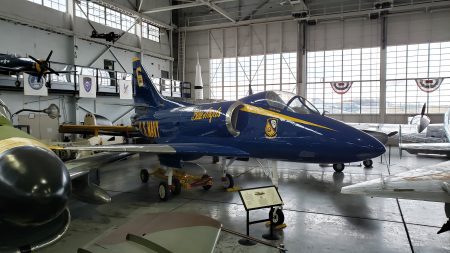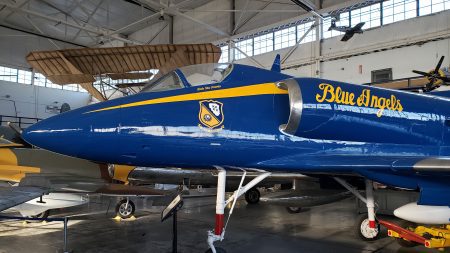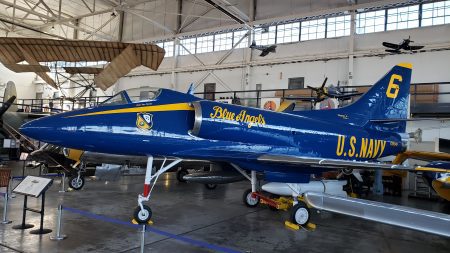Our Aircraft’s History
Douglas A-4A “Skyhawk” (Bureau #139947; MSN #11312) ~ Our delta-winged Skyhawk was built as an A4D-1 Skyhawk before being redesignated an A-4A in 1962. Capable of carrying the bomb load equivalent of WWII-era B-17 Flying Fortress, but still considered a “light” fighter. The Douglas aircraft earned many other nicknames by her pilots/crew, i.e. “Scooter”, “Kiddiecar”, “Bantam Bomber”, “Tinker Toy Bomber”, and due to its speed & nimble performance, “Heinemann’s Hot-Rod”.
Our particular A-4 was built by Douglas Aviation in Long Beach, California and was accepted by the US Navy on December 11, 1956. She was immediately assigned to Attack Squadron (VA)-93, Naval Air Station (NAS) in Alameda, California. Here are her journeys:
- December 1957 – Deployed aboard (CV-14) USS Ticonderoga on December 16 to the Western Pacific Area
- February 1959 – Assigned to VA-56, NAS Miramar, California
- March 1959 – Assigned to VA-112, NAS Miramar, California
- March 1960 – Assigned t VA-126, NAS Miramar, California
- August 1961 – Assigned to VA-125, NAS Lemoore, California
- July 1962 – Assigned to Naval Air Reserve Training Command (NART), NAS, Los Alamitos, California
- February 1963 – Placed in storage at NAS Litchfield Park, Phoenix, Arizona
- October 1965 – Upon closure of the Litchfield Storage Facility, the aircraft was relocated to the Military Aircraft Storage and Disposition Center (MASDC), Davis-Monthan AFB, Arizona
- March 1966 – NAS Alameda, California
- May 1966 – Naval Air Rework Facility (NARF), Alameda, California; immediately to NAS, Twin Cities, Minneapolis-St. Paul, Minnesota to be converted to a TA-4A
- September 1968 – Assigned as ground trainer at NAS, Memphis, Tennessee
- June 1987 – Assigned to Nondestructive Inspection School, Chanute AFB, Rantoul, Illinois
- June 1988 – Placed on static display, Chanute Aerospace Museum, Rantoul, Illinois
After the Chanute museum closed in 2015, the Skyhawk was moved to her current location on December 13, 2015, the MAPS Air Museum. Here, she was renovated to her current museum status during 2016. and is currently maintained by Crew Chief Jim Jackson.
Specifications/Performance
- Role: Attack, fighter, aggressor aircraft

- Manufacturer: Douglas Aircraft (McDonnell Douglas)
- First flight: June 22, 1954
- Introduction: October 1, 1956
- Retired: 2003 (US); 2015 (Israeli AF)
- Produced: 1954-1979
- Built: 2,960
- Unit cost: $2.8-3.8 million
- Crew: 1
- Length: 40 ft 1.5 in
- Wingspan: 27 ft 6 in
- Height: 15 ft 2 in
- Empty weight: 9,853 lb
- Max takeoff weight: 24,500 lb
- Engine: 1 x Pratt & Whitney J52-P-6A turbojet, 8,500 lbf
- Max speed: 673 mph at sea level
- Range: 1,160 mi
- Ferry range: 2,525 mi
- Service ceiling: 42,250 ft
Armament, notable
- Guns: 2 x .79 in Colt Mk 12 cannon, 100 rounds each
- Rockets: 4 x LAU-10 rocket pods (each with 4 x 127 mm Mk 32 Zuni rockets)
- 4 x AIM-9 Sidewinder air-to-air missiles
- 2 x AGM-12 Bullpup air-to-surface missiles
- 2 x AGM-45 Shrikeanti-radiation air-to-surface
- 2 x AGM-62 Walleye TV-guided glide bomb
- 2 x AGM-65 Maverick air-to-surface missile
- 6 x Rockeye-II Mark 20 Cluster Bomber Unit(CBU)
- Mark 80 series of unguided bombs
- B43, B57 or B61 nuclear bomb
Museum display notes: our A-4A is painted and marked to represent an A-4F as flown by the US Navy Blue Angels Demonstration Team from 1974-1986.
The name depicted on the cockpit is a tribute to Lieutenant Commander Stu Powrie, a 1966 graduate of Firestone High School in Akron, Ohio. He was chosen for the Navy’s Blue Angels and flew aircraft #6, the opposing solo, in airshows in 1981. He was to be the lead solo the following year but was killed when his aircraft crashed during practice on February 22, 1982. The aircraft was dedicated at MAPS on November 5, 2016 during our Veterans Celebration IV.
Designed to replace: Douglas A-1 “Skyraider”
Replaced by: LTV A-7 “Corsair II” (US Navy); McDonnell Douglas AV-8B Harrier II (US Marines)







